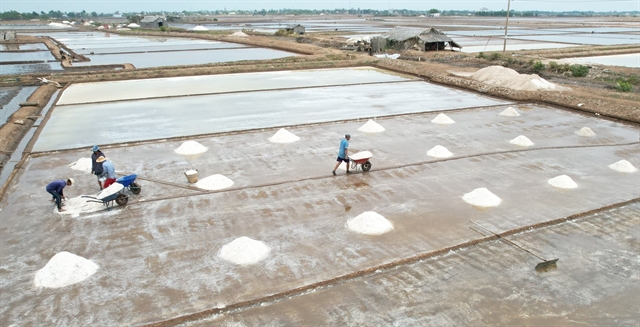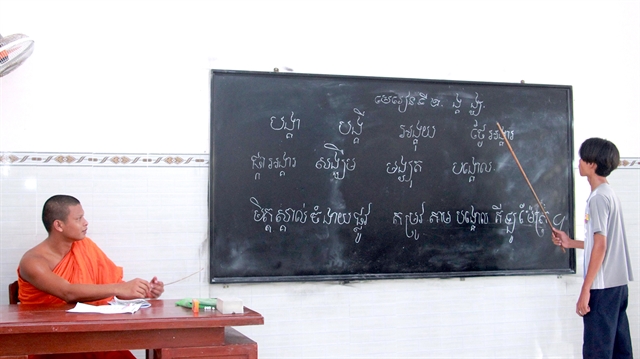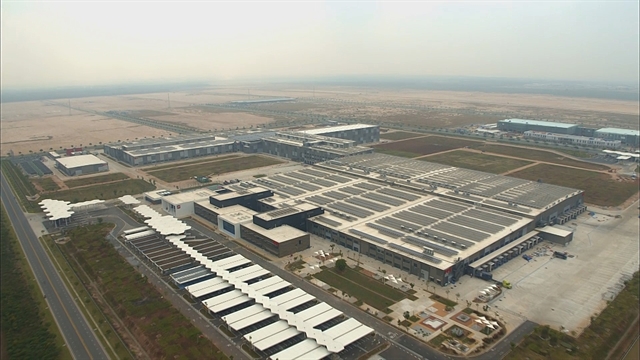 Society
Society

 |
| Children in the southern province of Bạc Liêu are encouraged to take Khmer script classes during the summer. VNA/VNS Photo Chanh Đa |
BẠC LIÊU During the summer, parents from villages and communes with a large ethnic Khmer population in Bạc Liêu Province eagerly take their children to temples to learn the Khmer script.
This activity aims to preserve and promote the Khmer language, while also helping children stay away from smart phones, TVs, and computers, and immerse themselves in their cultural heritage through lessons at the temple.
Throughout the summer months, Sơn Thị Phe takes her two grandchildren to Moniserey Sophon Cosđôn Temple in Vĩnh Phú Tây Commune in Phước Long District to learn Khmer letters and get to know the basics of the Khmer script.
"Trying to get them to learn a few letters like 'Co-Kho’, which are the first consonants in the Khmer alphabet over the summer is worthwhile. If they keep at it for a few summers, they will be able to read and write in Khmer," Phê said.
During classes, the temple's management board and Venerable Thạch Dương Trung, the abbot of Moniserey Sophon Cosđôn Temple, encourage pupils to attend regularly and study diligently so they can read and write their ethnic language, which will serve as valuable knowledge for the future.
This summer, the temple has 60 children attending Khmer script classes in three grades, from first to third.
At Komphirsakor Prêk Chru Temple in Vĩnh Trạch Đông Commune, six Khmer script classes have been conducted since the last week of May, including four first grade classes, one second grade class, and one third grade class.
The classes are divided into two sessions per day, taught by the temple's monks.
Venerable Dương Quân, the abbot of the Xiêm Cán Temple, said, "Teaching Khmer script during the summer at the temple has become an annual tradition, widely supported by the Buddhist followers. The students are very enthusiastic about learning. The temple's spacious, green campus is also well-suited for holding classes, helping children learn to read and write Khmer."
Venerable Tăng Sa Vong, deputy chairman of the Bạc Liêu Provincial Committee for Solidarity of Patriotic Monks and abbot of Buppharam Temple in Hưng Hội Commune in Vĩnh Lợi District, said that 20 out of 22 Theravada Buddhist temples in the province have opened Khmer script classes for the summer of 2024.
Besides teaching Khmer language and literature, many temples in the province also offer Pali and Dharma classes for monks studying at the temple.
This summer, Buppharam Temple is hosting six classes for children from surrounding hamlets.
The temple is also ordering uniforms for students and preparing to install 10 additional computers for further teaching.
Development
Bạc Liêu is home to over 17,000 Khmer households, with more than 75,000 people, accounting for 7.6 per cent of the population.
Improved infrastructure has been facilitating education, trade, and travel for the Khmer community in the province, contributing to their overall development in recent years.
The Khmer community increasingly values preserving their cultural traditions and passing them on to future generations, including their script.
Phạm Văn Thiều, chairman of the Bạc Liêu Provincial People's Committee, said that the province's ethnic affairs and policies for ethnic minorities are given special attention, are implemented promptly and have achieved many positive results.
This includes financial support for Khmer language and script teachers during the summer and allocating local funds exceeding central government requirements to implement the National Target Programme for socio-economic development in ethnic minority regions.
These efforts have led to significant improvements in the material and spiritual lives of the people.
The appearance of rural areas in ethnic minority regions is continually improving, educational levels are rising, and cultural traditions are being preserved and promoted.
Consequently, the poverty rate among ethnic minorities has significantly decreased, with only 808 poor households remaining, accounting for 3.86 per cent of the population. VNS




